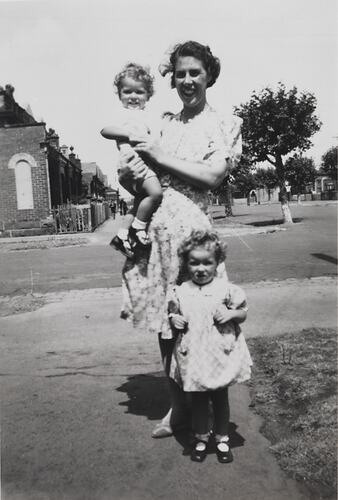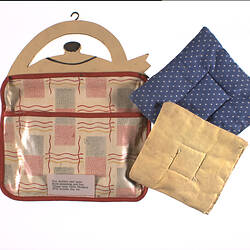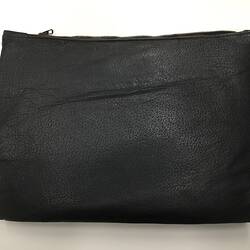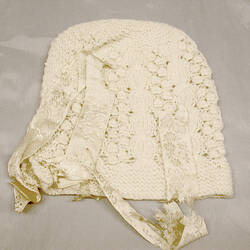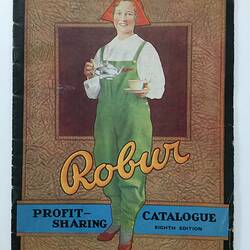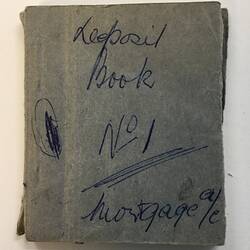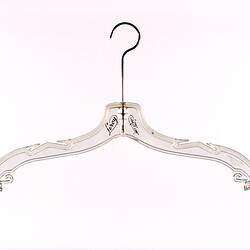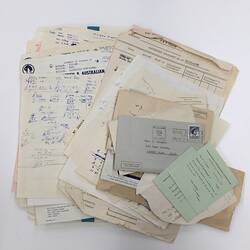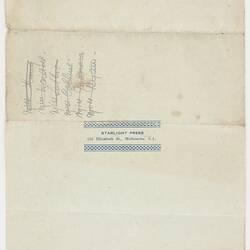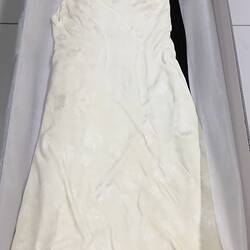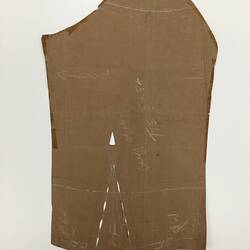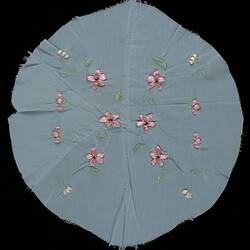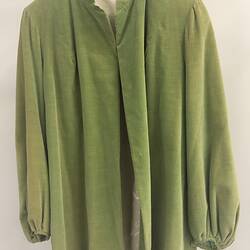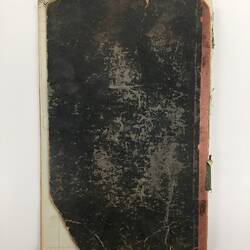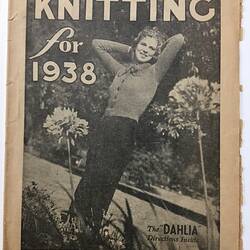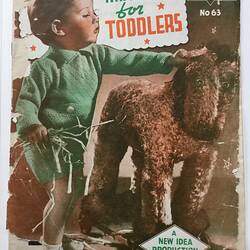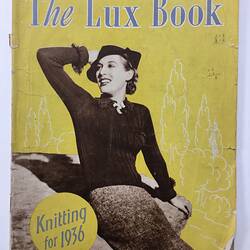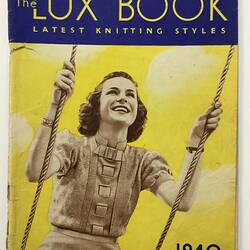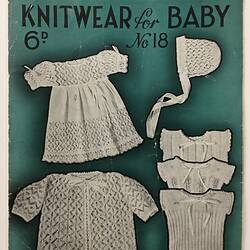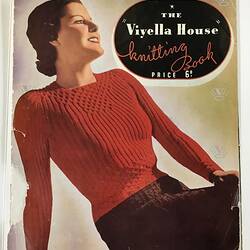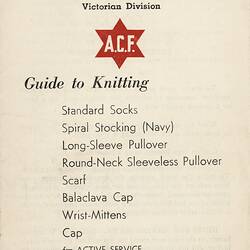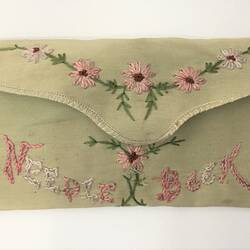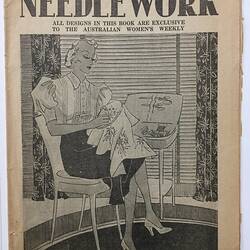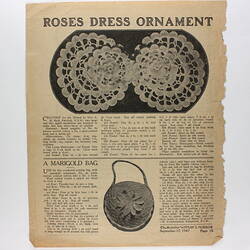In 1989 Vi (Violet) Morgan was interviewed by Jeanette Milner for Museums Victoria. Her interview was part of the South Melbourne Oral History Project, undertaken when Museums Victoria was planning to move to a new facility in Southbank (which did not eventuate). The following year Violet donated nearly 100 items from her home, including knitting patterns, booklets and several items of home-made clothing.
Violet Morgan, nee Waddell, was born in 1912, one of seven children. Her family lived in Prahran and then Glenhuntly (now Carnegie). Her father Robert was 'a very handy man' and taught Vi to do practical repairs. Her mother taught her to sew and make clothes, and her skills were sufficiently advanced by the age of 13 ½ that she left school (with an early leaving permit) and was employed by a 'high class factory'. She worked as a roustabout, then cutter, then did 'a bit of designing': effectively, she was an apprentice in the dressmaking trade.
As a young woman Vi played competitive tennis and often swam. She particularly enjoyed dancing: 'I used to dance three or four times a week at least... ballroom dancing, modern dancing, old-time dancing... I went by myself. Most of the girls went by themselves, used to stand around and the boys [...girls?] used to line across the room like wallflowers and you'd stand hoping someone would ask you for a dance and as I was a good dancer I had a good time.' (1989 interview, p. 1439). A 1934 dance program was donated by Vi (SH 901264, Dance Programme - Grand Spring Carnival, Victorian Council Against War). Vi also enjoyed watching the ballet and bought a ticket to the Australian Ballet at least once a year.
In September 1935, at the age of 23, Vi married Ivor James Morgan, who was 20 years her senior. Although Vi gave little information about his background in the interview, other sources suggest he was a Welsh immigrant who had been married and widowed previously (requires further verification), and may have served as a cook in the British merchant navy during World War I. Their first married home was in Bridport Street, Albert Park, where they remained for three years. They lived in half a house and used two front rooms, with a passage to a shared kitchen. Ivor was a trained chef, but he was laid off after they were married, so Vi kept working and he began selling door-to-door. (The 1937 Australian Electoral Rolls locate them at 227 Bridport St, when Vi was described as 'cutter' and Ivor as 'clerk'). He 'helped very considerably' around the home - washing, ironing and sweeping. Vi cooked, although she was rather embarrassed as her husband was a chef, 'But he said anything that was done, he was most grateful for'. They took turns with the other residents to fire up a wood-burning copper in an outbuilding to do laundering, which she and Ivor did together on Saturday mornings, with Ivor chopping the wood.
After they left Bridport Street around 1938, Vi and Ivor went to live behind a shop in Malvern, where her brother and his wife had previous lived before moving to the country. But their home was too far from her husband's new job delivering bread, so they soon moved to a larger brick house in Napier Street, South Melbourne, then to 105 Page Street, Albert Park.
Their first baby, Kay was born in April 1941, followed by James (Jimmie) Ivor in September 1942, and then Russell. (The children are depicted in photographs including SH 900631 and SH 900794). Vi's parents, Robert & Elizabeth, and her two younger sisters moved in with them for a time (p.1418), as her father was not well and her mother 'had to attend hospital'. The house was very crowded. Baby Kay was bathed in a tub on the kitchen table. The house had a wood copper in the kitchen.
Life was also hard because it was wartime. Adding to the family's commitments, Ivor was an Air Raid Precautions warden, in charge of a sector, and 'he had us practicing with the buckets and the stirrup pimp timing how quickly he could get to places' (p. 1419). Things 'were hard to get', such as coke for the fire, which sometimes had to be picked up from the gasworks in South Melbourne in a pram (p. 1400). The coke was 'very dirty really, coke goes into a dust and very fine and it's like a sulphur colour and it would drift all over the house. You were forever dusting. You would dust more here than other houses because you were on the street and the windows were old and there'd be a lot of dust.' (p. 1402)
Vi was a diligent housekeeper, although she did not enjoy the work (p.1411). 'You wanted to keep your house clean and your children clean and there was always washing and ironing.' (p. 1443). A later household account book (SH 901718, 1966) shows her methodical approach to her work. Vi was also part of the Mother's Club for 39 years (p. 1449).
She was a keen and skilled sewer, and made her own clothes, such as SH 900655, and clothing for her family (p. 1432). She had a treadle machine which later had a motor attachment (p. 1394). She also made clothing for neighbours' children, for very little or no money - she just loved doing it. She especially liked making evening wear (p. 1396). In later life she made aprons and 'little moppity things' for charity.
In February 1946 tragedy struck: Ivor died at the age of 55. Vi found times very hard as a widow with three young children, and her sister moved in to help her.
Vi received a pension but had to take on work outside the home to make ends meet. At one stage she worked at Sunbeam Manufacturing Co. as a general hand (per SH 900630); later she worked in a cake shop (p. 1411) and as a 'checkout girl' at an early supermarket (p. 1373).
Vi recalled that she 'would be very tired and so tired at one stage that I went to the doctor. I said 'I would prefer to sit down and sew but there's so many other things and the children want this, that and the other'.' The doctor advised her to follow the lead of Ma Kettle, a film character of the time, who 'just used to sweep everything to the end of the table and she'd put a cup and saucer down in front of her guests and that was that . [So] I did that.' (pp. 1442-3)
Around 1959 Vi jointly purchased 105 Page Street, Albert Park with Rev Dr Max Wilcox (of Albert Park - Middle Park Presbyterian Church) and Mrs Patricia Lorraine Wilcox (per HT 28092 - conveyancing documents). She was still living there when interviewed in 1989.
Vi continued her other interests in later life, such as attending South Melbourne Tech for 10 years on Wednesday mornings for discussions about books and other topics (p. 1447). She particularly enjoyed being part of the South Melbourne community, and in her interview describes the value and support of the community in difficult times.
References
Audio Recording - Interview with Vi Morgan, South Melbourne Oral History Project, 21 Aug 1989. Museums Victoria collection HT 14306.
Mrs Violet (Vi) Morgan collection, Museums Victoria.
Birth, Violet Waddell, father Robt Waddell, Birth Index Ref. No., 18304.
Australian Electoral Rolls, 1928: Subdivision of Carlton, p. 26 (Ivor James Morgan, cook).
Australian Electoral Rolls, 1934: Subdivision of Glenhuntly, p.117: Violet Waddell, Cutter is living at 31 Grange Rd, Glenhuntly, with her parents and probably her siblings Robert (turner) and Vera (laundress).
Marriage, Violet Waddell to Ivor James Morgan, September 1935, Marriage Index Reference no. 8001.
Australian Electoral Rolls, 1937: Subdivision of Albert Park, p. 142 (Vi and Ivor, cutter & clerk, living at 227 Bridport St).
1946 'Family Notices', The Herald (Melbourne, Vic. : 1861 - 1954), 22 February, p. 4. , viewed 25 May 2022, http://nla.gov.au/nla.news-article245948256
Steel family tree, Ancestry, Ivor James Morgan - Facts (ancestrylibrary.com.au) accessed 25/5/2022.
Gale family tree, Ancestry, Violet Waddell - Facts (ancestrylibrary.com.au), accessed 26/5/2022.
More Information
-
Keywords
-
Localities
Melbourne, Victoria, Australia, South Melbourne, Victoria, Australia
-
Authors
-
Article types
